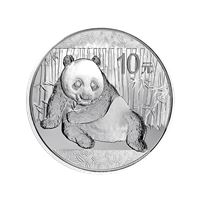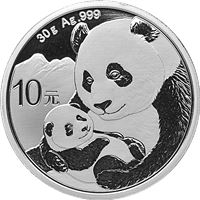The History of the Chinese Silver Panda Coin
Taking a cue from the success of the 1982 Chinese Gold Panda Coin, the People’s Republic of China added silver coinsto the series in 1983. For over two decades, these silver Chinese Panda coins haveremained popular among collectors for their numismatic beauty and natural whimsy.Meanwhile, investors appreciate the silver Panda coins; because the coins’ purity, weight, and content are guaranteedby the People’s Republic of China, no assaying is necessary to convert the coininto cash. Thus the Silver Chinese Panda enjoys an outstanding reputation amongboth collectors and investors.
An Inconsistent Beginning
From 1983 to 1985, the silver Panda coin did not weight a proper troy ounce. Furthermore,its fineness was only 90%. These were odd choices for silver bullion coins, and in 1987, the fineness was increased to the standard99.99%. No Chinese Silver Panda coin was issued in 1986 or 1988. Although it isunknown exactly why no silver Panda coins were issued in these years, it has beenspeculated that the 1988 mintage of the Year of the Rabbit, Year of the Dragon,Olympics, and Endangered Wildlife coins took precedence.
Expanding the Mintage
Until 1989, the Chinese Silver Panda coins were minted only in Shanghai. However, as thecoins’ popularity grew, the People’s Republic of China increased mintage. In 1990,the coins were also minted at Shenyang. By 1999, silver Panda coins were mintedin Shanghai, Shenyang, and Shenzhen.
The People’s Republic of China also added a 1 kilo silver coin to the series in1998. Exactly 1,998 of the coins were minted. This unusual pattern was continuedfor two years, with 1,999 coins issued in 1999, and 2,000 coins produced in 2000.Production was capped at 2,000 1 kilo coins, until 2002. From 2002 to the present,4,000 1 kg Chinese Silver Panda coins were minted, with the exception of 2003. Only2,000 of these coins were minted that year. A special anniversary set, with a coinfrom each year, was also issued in 2007.
Iconic Design
Each year, the obverse of the Panda coin features a different portrait of China’s most recognized wildlife.In 2001, the People’s Republic of China froze the design, so the 2001 and 2002 SilverPanda have the same obverse design. After collectors protested, however, that freezewas lifted, and subsequent designs have been unique.
On the Chinese Silver Panda’s reverse is an extraordinary etching of the Templeof Heaven. Located in Beijing, the Temple was built during the Ming Dynasty in thefifteenth century, as a place for China’s royalty and elite to worship. This reversedesign has remained largely unchanged. However, in 1987, when the coin’s finenessand weight were changed, the Temple of Heaven design was altered slightly: the numberof posts in the stone fence that surrounds the temple was changed.
The immense value and beauty of the Chinese Silver Panda coin have made it an extremelysuccessful addition to the world of international numismatics. These coins willundoubtedly continue to appeal to collectors and investors alike.
This information is provided for general reference purposes and does not constituteprofessional advice. For detailed coin collecting or investing information, pleaseconsult with a professional expert.
product


